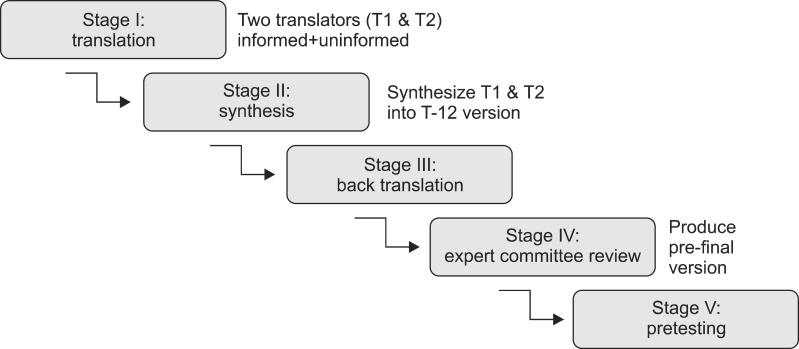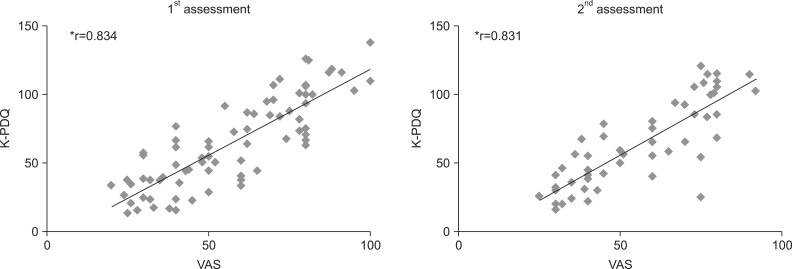Ann Rehabil Med.
2013 Dec;37(6):814-823. 10.5535/arm.2013.37.6.814.
Reliability and Validity of the Korean Version of the Pain Disability Questionnaire
- Affiliations
-
- 1Department of Rehabilitation Medicine, Asan Medical Center, University of Ulsan College of Medicine, Seoul, Korea. khchoi@amc.seoul.kr
- 2Department of Rehabilitation Medicine, Seoul St. Mary's Hospital, The Catholic University of Korea College of Medicine, Seoul, Korea.
- KMID: 2266560
- DOI: http://doi.org/10.5535/arm.2013.37.6.814
Abstract
OBJECTIVE
To translate the English version of the Pain Disability Questionnaire (PDQ) into Korean and to investigate the reliability and validity of the Korean version of the PDQ (K-PDQ) in patients suffering chronic disabling musculoskeletal disorders (CDMDs).
METHODS
The English version of the PDQ was translated into Korean. Ten patients with CDMDs were randomly selected for a pilot study to assess the comprehensibility of the pre-final version. One hundred and thirty-nine patients suffering from CDMDs for more than 3 months were enrolled in this study. Follow-up questionnaires were obtained to examine the test-retest reliability. Concurrent validity was evaluated by comparing the K-PDQ with the visual analogue scale (VAS). Construct validity was evaluated by comparing the K-PDQ with the brief form of the World Health Organization quality of life assessment instrument (WHOQOL-BREF) using Pearson correlation coefficient. Reliability was assessed using the intraclass correlation coefficient (ICC), and internal consistency was determined by Cronbach's alpha.
RESULTS
Test-retest reliability was assessed in 70 patients, with an average time interval of 12 days. The ICC was 0.958 (p<0.001). Internal consistency reached Cronbach's alpha of 0.933 for the functional component and 0.870 for the psychosocial component. The correlation coefficient for the K-PDQ when compared with the VAS was 0.834 in the first assessment and 0.831 in the second assessment. All domains of the WHOQOL-BREF showed a significant negative correlation with the K-PDQ.
CONCLUSION
The K-PDQ is a reliable and valid instrument for measuring disability and can be used to assess disability and treatment outcomes in Korean patients with CDMD.
Keyword
MeSH Terms
Figure
Reference
-
1. Bergman S. Public health perspective: how to improve the musculoskeletal health of the population. Best Pract Res Clin Rheumatol. 2007; 21:191–204. PMID: 17350552.2. Ricci JA, Stewart WF, Chee E, Leotta C, Foley K, Hochberg MC. Back pain exacerbations and lost productive time costs in United States workers. Spine (Phila Pa 1976). 2006; 31:3052–3060. PMID: 17173003.
Article3. Gatchel RJ, Polatin PB, Mayer TG. The dominant role of psychosocial risk factors in the development of chronic low back pain disability. Spine (Phila Pa 1976). 1995; 20:2702–2709. PMID: 8747248.
Article4. Polatin PB, Gatchel RJ, Barnes D, Mayer H, Arens C, Mayer TG. A psychosociomedical prediction model of response to treatment by chronically disabled workers with low-back pain. Spine (Phila Pa 1976). 1989; 14:956–961. PMID: 2528825.
Article5. Gatchel RJ, Polatin PB, Kinney RK. Predicting outcome of chronic back pain using clinical predictors of psychopathology: a prospective analysis. Health Psychol. 1995; 14:415–420. PMID: 7498112.
Article6. Gatchel RJ, Mayer TG, Theodore BR. The pain disability questionnaire: relationship to one-year functional and psychosocial rehabilitation outcomes. J Occup Rehabil. 2006; 16:75–94. PMID: 16752090.
Article7. Anagnostis C, Gatchel RJ, Mayer TG. The pain disability questionnaire: a new psychometrically sound measure for chronic musculoskeletal disorders. Spine (Phila Pa 1976). 2004; 29:2290–2302. PMID: 15480144.8. Giordano PC, Alexandre NM, Rodrigues RC, Coluci MZ. The Pain Disability Questionnaire: a reliability and validity study. Rev Lat Am Enfermagem. 2012; 20:76–83. PMID: 22481724.
Article9. Kopec JA. Measuring functional outcomes in persons with back pain: a review of back-specific questionnaires. Spine (Phila Pa 1976). 2000; 25:3110–3114. PMID: 11124726.10. Polatin PB, Kinney RK, Gatchel RJ, Lillo E, Mayer TG. Psychiatric illness and chronic low-back pain. The mind and the spine: which goes first? Spine (Phila Pa 1976). 1993; 18:66–71. PMID: 8434327.11. Dersh J, Gatchel RJ, Polatin P. Chronic spinal disorders and psychopathology: research findings and theoretical considerations. Spine J. 2001; 1:88–94. PMID: 14588387.12. Dersh J, Gatchel RJ, Polatin P, Mayer T. Prevalence of psychiatric disorders in patients with chronic work-related musculoskeletal pain disability. J Occup Environ Med. 2002; 44:459–468. PMID: 12024691.
Article13. Beaton DE, Bombardier C, Guillemin F, Ferraz MB. Guidelines for the process of cross-cultural adaptation of self-report measures. Spine (Phila Pa 1976). 2000; 25:3186–3191. PMID: 11124735.
Article14. Hawker GA, Mian S, Kendzerska T, French M. Measures of adult pain: Visual Analog Scale for Pain (VAS Pain), Numeric Rating Scale for Pain (NRS Pain), McGill Pain Questionnaire (MPQ), Short-Form McGill Pain Questionnaire (SF-MPQ), Chronic Pain Grade Scale (CPGS), Short Form-36 Bodily Pain Scale (SF-36 BPS), and Measure of Intermittent and Constant Osteoarthritis Pain (ICOAP). Arthritis Care Res (Hoboken). 2011; 63(Suppl 11):S240–S252. PMID: 22588748.15. Jensen MP, Karoly P, Braver S. The measurement of clinical pain intensity: a comparison of six methods. Pain. 1986; 27:117–126. PMID: 3785962.
Article16. Min SK, Kim KI, Lee CI, Jung YC, Suh SY, Kim DK. Development of the Korean versions of WHO Quality of Life scale and WHOQOL-BREF. Qual Life Res. 2002; 11:593–600. PMID: 12206580.17. The WHOQOL Group. Development of the World Health Organization WHOQOL-BREF quality of life assessment. Psychol Med. 1998; 28:551–558. PMID: 9626712.18. Johansson E, Lindberg P. Subacute and chronic low back pain: reliability and validity of a Swedish version of the Roland and Morris Disability Questionnaire. Scand J Rehabil Med. 1998; 30:139–143. PMID: 9782540.19. Liu H, Tao H, Luo Z. Validation of the simplified Chinese version of the Oswestry Disability Index. Spine (Phila Pa 1976). 2009; 34:1211–1216. PMID: 19444069.
Article20. Lee JS, Lee DH, Suh KT, Kim JI, Lim JM, Goh TS. Validation of the Korean version of the Roland-Morris Disability Questionnaire. Eur Spine J. 2011; 20:2115–2119. PMID: 21479853.
Article21. Tsang A, Von Korff M, Lee S, Alonso J, Karam E, Angermeyer MC, et al. Common chronic pain conditions in developed and developing countries: gender and age differences and comorbidity with depression-anxiety disorders. J Pain. 2008; 9:883–891. PMID: 18602869.
Article22. Rustoen T, Wahl AK, Hanestad BR, Lerdal A, Paul S, Miaskowski C. Gender differences in chronic pain: findings from a population-based study of Norwegian adults. Pain Manag Nurs. 2004; 5:105–117. PMID: 15359222.
- Full Text Links
- Actions
-
Cited
- CITED
-
- Close
- Share
- Similar articles
-
- Reliability, Validity, and Responsiveness of the Korean Version of the Shoulder Disability Questionnaire and Shoulder Rating Questionnaire
- Cross-Cultural Adaptation, Validity, and Reliability of the Persian Version of the Orebro Musculoskeletal Pain Screening Questionnaire
- Validity and Reliability of the Arabic Version of the Copenhagen Neck Functional Disability Scale in Neck Pain Patients
- Cross-Cultural Adaptation, Validation, and Reliability Testing of the Modified Oswestry Disability Questionnaire in Persian Population with Low Back Pain
- Development of the Korean-version of Female Sexual Function Index (FSFI)



